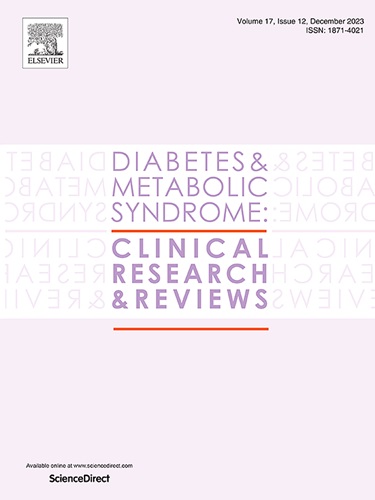Relationship between preconception protein intake and gestational diabetes mellitus: The Japan Environment and Children's Study
IF 3.4
Q1 ENDOCRINOLOGY & METABOLISM
Diabetes & Metabolic Syndrome-Clinical Research & Reviews
Pub Date : 2025-02-01
DOI:10.1016/j.dsx.2025.103200
引用次数: 0
Abstract
Aims
To investigate the relationship between preconception protein intake and the risk of gestational diabetes mellitus (GDM).
Methods
We analyzed data from the Japan Environment and Children's Study, focusing on 80,346 participants (mean age 31.3 ± 4.9 years; mean body mass index 21.2 ± 3.2 kg/m2) who delivered between 2011 and 2014. These participants had no history of diabetes mellitus, no previous diagnosis of GDM, and did not use steroids during pregnancy. Participants were categorized into five groups based on preconception protein energy ratio quintiles (Q1 and Q5 represent the lowest and highest intake, respectively). Continuous variables were compared using one-way analysis of variance or the Kruskal–Wallis test, and categorical variables using chi-square tests. Primary outcomes were GDM, early-diagnosed GDM (Ed-GDM, diagnosed at <24 weeks), and late-diagnosed GDM (Ld-GDM, diagnosed at >24 weeks). Adjusted odds ratios (aORs) and 95 % confidence intervals (CIs) were calculated using logistic regression analysis with the middle quintile (Q3) as the reference.
Results
Multiple logistic regression analysis revealed that using the Q3 group as the reference, the Q5 group had a higher risk of Ed-GDM (aOR 1.48, 95 % CI 1.06–2.07), whereas the Q1 group had a lower risk of Ed-GDM (aOR 0.69, 95 % CI 0.48–0.996). However, no significant differences were observed in the risk of GDM and Ld-GDM.
Conclusions
Higher preconception protein intake was associated with increased Ed-GDM risk. Further research is needed to refine dietary recommendations for preconception protein intake.
孕前蛋白质摄入与妊娠期糖尿病的关系:日本环境与儿童研究
目的探讨孕前蛋白质摄入与妊娠期糖尿病(GDM)风险的关系。方法:我们分析了来自日本环境与儿童研究的数据,重点研究了80,346名参与者(平均年龄31.3±4.9岁;2011 - 2014年间分娩的平均体重指数(21.2±3.2 kg/m2)。这些参与者没有糖尿病史,以前没有GDM的诊断,并且在怀孕期间没有使用类固醇。参与者根据孕前蛋白质能量比五分位数分为五组(Q1和Q5分别代表最低和最高摄入量)。使用单向方差分析或Kruskal-Wallis检验比较连续变量,使用卡方检验比较分类变量。主要结局为GDM、早期诊断的GDM (Ed-GDM,诊断于24周)和晚期诊断的GDM (Ld-GDM,诊断于24周)。以中间五分位数(Q3)为参考,采用logistic回归分析计算调整优势比(aORs)和95%置信区间(ci)。结果以Q3组为对照,Q5组Ed-GDM发生风险较高(aOR 1.48, 95% CI 1.06 ~ 2.07), Q1组Ed-GDM发生风险较低(aOR 0.69, 95% CI 0.48 ~ 0.996)。然而,在GDM和Ld-GDM的风险上没有观察到显著差异。结论较高的孕前蛋白质摄入量与Ed-GDM风险增加有关。需要进一步的研究来完善孕前蛋白质摄入的饮食建议。
本文章由计算机程序翻译,如有差异,请以英文原文为准。
求助全文
约1分钟内获得全文
求助全文
来源期刊

Diabetes & Metabolic Syndrome-Clinical Research & Reviews
ENDOCRINOLOGY & METABOLISM-
CiteScore
22.90
自引率
2.00%
发文量
248
审稿时长
51 days
期刊介绍:
Diabetes and Metabolic Syndrome: Clinical Research and Reviews is the official journal of DiabetesIndia. It aims to provide a global platform for healthcare professionals, diabetes educators, and other stakeholders to submit their research on diabetes care.
Types of Publications:
Diabetes and Metabolic Syndrome: Clinical Research and Reviews publishes peer-reviewed original articles, reviews, short communications, case reports, letters to the Editor, and expert comments. Reviews and mini-reviews are particularly welcomed for areas within endocrinology undergoing rapid changes.
 求助内容:
求助内容: 应助结果提醒方式:
应助结果提醒方式:


